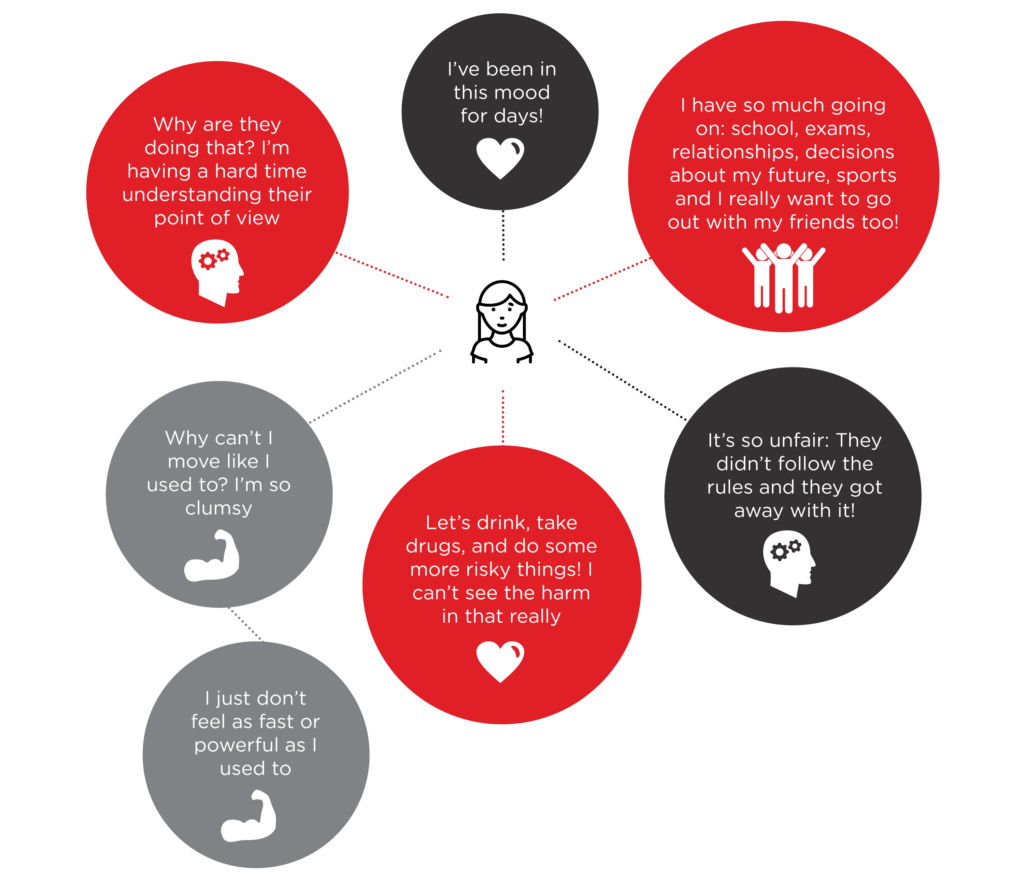Mid adolescence (~13-18)

![]() The pre-frontal cortex in the adolescent brain isn’t fully developed yet and it is this part of the brain that is associated with things like regulating emotion and recognising risks. So, adolescents are a bit like a fast car, with poor brakes and will find it harder to manage their emotions/mood and to see the risks in situations. Therefore, providing opportunities for athletes to explore and take risks can be helpful for their growth but remember you’re still the adult, and if things are getting out of hand, you can step in.
The pre-frontal cortex in the adolescent brain isn’t fully developed yet and it is this part of the brain that is associated with things like regulating emotion and recognising risks. So, adolescents are a bit like a fast car, with poor brakes and will find it harder to manage their emotions/mood and to see the risks in situations. Therefore, providing opportunities for athletes to explore and take risks can be helpful for their growth but remember you’re still the adult, and if things are getting out of hand, you can step in.
Similarly, be prepared for some emotional displays at times: these are not good or bad, they just are. Spend a bit of time being curious with them and help them understand what factors have caused them to feel this way. The more links you can help them make between their experience and their emotions, the better they will be able to regulate their emotions in the future.
![]() It is important to make rules simplistic, well defined, and clear at this stage, because athletes have a strong sense of fairness. It can also help to make athletes a part of the decision making. As critical thinking has also developed by this age, allowing athletes to input into their training and making them think for themselves, can help them learn. For example, after execution of a skill, you could ask athletes to rate their performance on a scale from red, amber, to green and highlight what went right and what didn’t go to plan.
It is important to make rules simplistic, well defined, and clear at this stage, because athletes have a strong sense of fairness. It can also help to make athletes a part of the decision making. As critical thinking has also developed by this age, allowing athletes to input into their training and making them think for themselves, can help them learn. For example, after execution of a skill, you could ask athletes to rate their performance on a scale from red, amber, to green and highlight what went right and what didn’t go to plan.
Furthermore, the part of the brain associated with empathy isn’t fully developed at this age, and so athletes may struggle to see things from other perspectives and empathise with another person. To support this, you can ask them questions and explain how another person might see a situation differently to them.
![]() There is a lot going on for athletes at this age in their social and personal lives and they have a lot of ‘pulls’ on their time and energy (i.e. exams and friends). Athletes are also more likely to feel pressured by their peers to go along with the group. Therefore, make sure you’re aware of their external pressures but treat them like adults, by helping them make informed decisions.
There is a lot going on for athletes at this age in their social and personal lives and they have a lot of ‘pulls’ on their time and energy (i.e. exams and friends). Athletes are also more likely to feel pressured by their peers to go along with the group. Therefore, make sure you’re aware of their external pressures but treat them like adults, by helping them make informed decisions.
![]() Some individuals may experience a loss in coordination, accuracy and balance as their bodies continue to change size and shape. Previously well learnt skills may become disrupted, and athletes may look awkward or clumsy. Coaches can support athletes by providing opportunities to regress and recalibrate skills and movement patterns.
Some individuals may experience a loss in coordination, accuracy and balance as their bodies continue to change size and shape. Previously well learnt skills may become disrupted, and athletes may look awkward or clumsy. Coaches can support athletes by providing opportunities to regress and recalibrate skills and movement patterns.
Additionally, explosive abilities such as running, jumping, and changing direction may decline as changes in height and weight outweigh natural increases in strength and power. Appropriate physical training as outlined in the ‘physical development curriculum’ should be encouraged to help to restore previous levels of relative strength and power. We encourage coaches to be patient and supportive with any temporary loses in performance that may occur.
How might you support an athlete who displays erratic and unpredictable emotions during this stage?
Can you identify any strategies to manage the expectations and reassure athletes who experience a dip or plateau in performance following growth?










